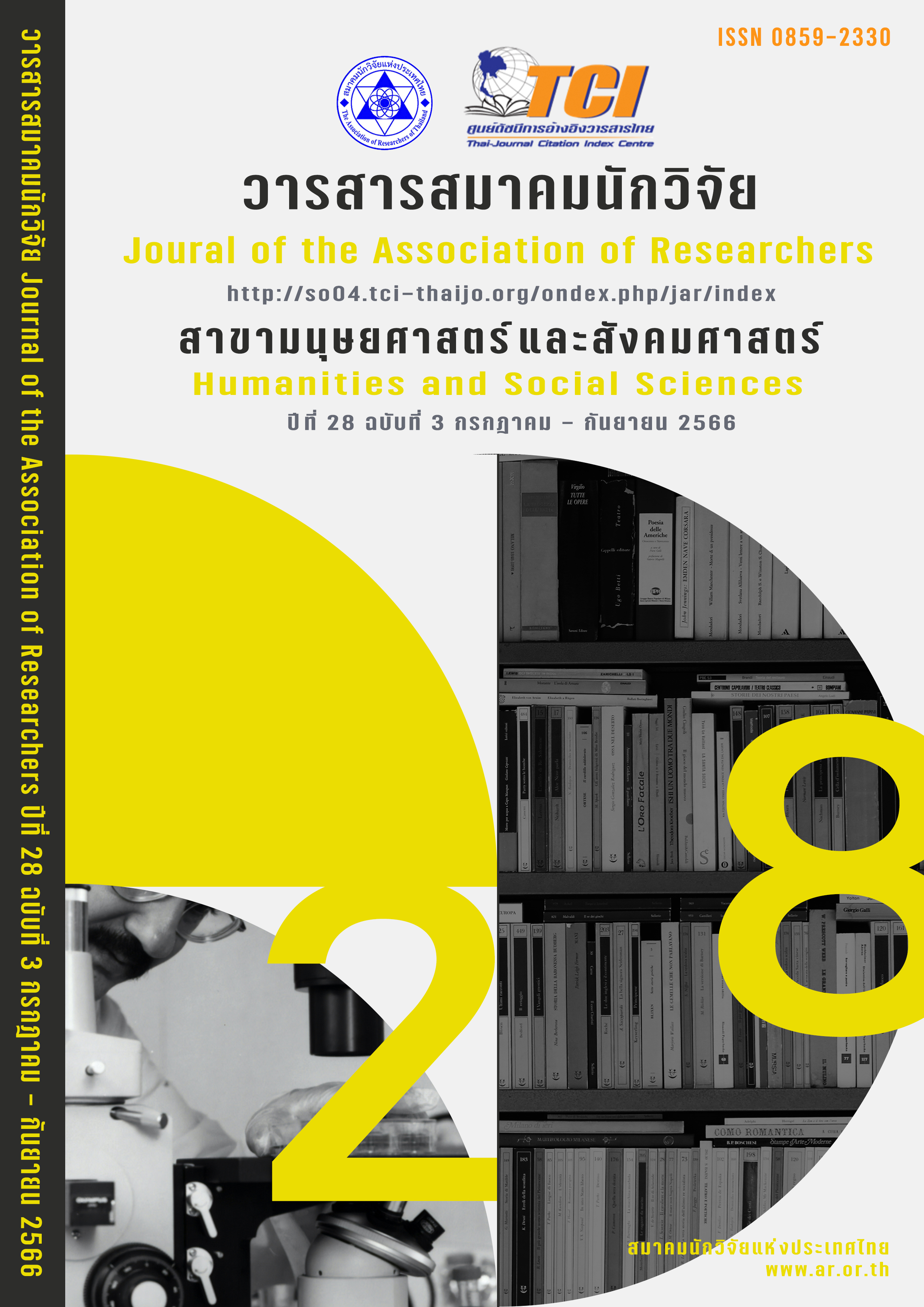คุณลักษณะของผลิตภัณฑ์บำรุงผิวกายผสมกัญชา-กัญชง ที่ผู้บริโภคเลือกซื้อในเขตกรุงเทพมหานคร
Main Article Content
บทคัดย่อ
การศึกษาวิจัยครั้งนี้มีวัตถุประสงค์ 1) เพื่อศึกษาความสัมพันธ์ระหว่างปัจจัยประชากรศาสตร์และการรับรู้พฤติกรรมการเลือกซื้อผลิตภัณฑ์บำรุงผิวกายผสมกัญชา-กัญชงของผู้บริโภคในเขตกรุงเทพมหานคร
2) เพื่อศึกษาคุณลักษณะผลิตภัณฑ์ของผลิตภัณฑ์บำรุงผิวกายผสมกัญชา-กัญชงที่ผู้บริโภคเลือกซื้อ 3) เพื่อศึกษาความสัมพันธ์ระหว่างปัจจัยประชากรศาสตร์และคุณลักษณะผลิตภัณฑ์ของผลิตภัณฑ์บำรุงผิวกายผสมกัญชา-กัญชง ที่ผู้บริโภคเลือกซื้อในเขตกรุงเทพมหานคร งานวิจัยนี้เป็นการวิจัยเชิงปริมาณ โดยใช้แบบสอบถามเป็นเครื่องมือในเก็บรวบรวมข้อมูลจากกลุ่มตัวอย่างจำนวน 411 คน เป็นประชากรที่มีความสนใจหรือมีโอกาสในการเลือกซื้อ หรือเลือกใช้ผลิตภัณฑ์บำรุงผิวกายผสมกัญชา-กัญชง ในเขตกรุงเทพมหานคร สถิติที่ใช้ในการวิเคราะห์ข้อมูล ได้แก่ การแจกแจงความถี่ ร้อยละ ค่าเฉลี่ย และดำเนินการทดสอบสมมติฐานด้วยสถิติไคสแควร์ ค่าสถิติที และความแปรปรวนทางเดียว ที่ระดับนัยสำคัญทางสถิติ 0.05 ผลการศึกษาวิจัย พบว่า 1) ปัจจัยประชากรศาสตร์ด้านเพศ อายุ สถานภาพสมรส การศึกษา อาชีพ และรายได้เฉลี่ยต่อเดือน มีความสัมพันธ์กับพฤติกรรมการเลือกซื้อผลิตภัณฑ์บำรุงผิวกายผสมกัญชา-กัญชงอย่างมีระดับนัยสำคัญ ทางสถิติที่ระดับ 0.05 2) กลุ่มตัวอย่างให้ความสำคัญต่อคุณลักษณะผลิตภัณฑ์ของผลิตภัณฑ์บำรุงผิวกายผสมกัญชา-กัญชงที่เลือกซื้อในด้านเพิ่มความเนียนนุ่มชุ่มชื้นให้ผิว และ 3) ปัจจัยประชากรศาสตร์ด้านเพศ อายุ สถานภาพสมรส การศึกษา อาชีพ และรายได้เฉลี่ยต่อเดือนที่แตกต่างกัน มีผลต่อคุณลักษณะผลิตภัณฑ์ของผลิตภัณฑ์บำรุงผิวกายผสมกัญชา-กัญชงแตกต่างกัน อย่างมีนัยสำคัญทางสถิติที่ระดับ 0.05.
Article Details

อนุญาตภายใต้เงื่อนไข Creative Commons Attribution-NonCommercial-NoDerivatives 4.0 International License.
บทความที่ปรากฏในวารสารนี้ เป็นความรับผิดชอบของผู้เขียน ซึ่งสมาคมนักวิจัยไม่จำเป็นต้องเห็นด้วยเสมอไป การนำเสนอผลงานวิจัยและบทความในวารสารนี้ไปเผยแพร่สามารถกระทำได้ โดยระบุแหล่งอ้างอิงจาก "วารสารสมาคมนักวิจัย"
เอกสารอ้างอิง
กองควบคุมวัตถุเสพติด สำนักงานคณะกรรมการอาหารและยา. (2564). ประกาศกระทรวงสาธารณสุข เรื่อง การใช้ส่วนของกัญชงในเครื่องสำอาง พ.ศ. 2564. กรุงเทพฯ: สำนักคณะกรรมการอาหารและยา.
ฐานเศรษฐกิจดิจิทัล. (2565). 8เดือนไทยส่งออกเครื่องสำอางพุ่ง8% ตลาดอาเซียนครองแชมป์.
เข้าถึงจาก https://www.thansettakij.com/business/economy/544532.
ทีเอ็นพี คอสเมซูติคอล. (2566). เจาะลึก "กัญชง" ส่วนผสมมหัศจรรย์ของเครื่องสำอางยุคใหม่.
เข้าถึงจาก https://www.tnpoem.com/content/5319/insidehempbeauty.
ไทยโพสต์. (2565). ตลาดเครื่องสำอางคึก! คนแห่เข้าชมงานพุ่ง พร้อมจับคู่ธุรกิจกว่า 600 คู่.
เข้าถึงจาก https://www.thaipost.net/economy-news/237977/.
ธัญวลัย บุญมาก และพิพัฒน์ นนทนาธรณ์. (2564). ความรู้ ทัศนคติ และการปฏิบัติต่อการใช้กัญชาของประชากรในเขตภาคกลาง. วารสารสมาคมนักวิจัย, 26(2), 69-85.
ผู้จัดการออนไลน์. (2565). WGSN เปิด 7 เทรนด์ความงาม.
เข้าถึงจาก https://mgronline.com/business/detail/9650000093480.
พิพัฒน์ นนทนาธรณ์. (2561). รวมบทความว่าด้วย...ความรับผิดชอบต่อสังคม. กรุงเทพมหานคร: ศูนย์ผู้นำธุรกิจเพื่อสังคมแห่งมหาวิทยาลัยเกษตรศาสตร์.
พรชนก เจนศิริศักดิ์. (2564). กัญชาและกัญชงในผลิตภัณฑ์เครื่องสำอาง. วารสารการคุ้มครองผู้บริโภคด้าน สุขภาพ, 1(2), 7-10.
วริศรา ถนอมวงศ์ และพิพัฒน์ นนทนาธรณ์. (2565). คุณลักษณะของผลิตภัณฑ์บำรุงผิวหน้าผสมซีบีดีที่ผู้บริโภคเลือกซื้อในเขตกรุงเทพมหานคร. วารสารสมาคมนักวิจัย, 27(2), 186-200.
วิทวัส รุ่งเรืองผล. (2552). ตำราหลักการตลาด. กรุงเทพมหานคร: ศูนย์หนังสือมหาวิทยาลัยธรรมศาสตร์.
สุพฤกษา ท่าสระ. (2561). พฤติกรรมและการตัดสินใจซื้อเครื่องสำอางสมุนไพรของประชาชนใน
จังหวัดพระนครศรีอยุธยา. วิทยานิพนธ์บริหารธุรกิจมหาบัณฑิต, สาขาการจัดการ, คณะวิทยาการจัดการ, มหาวิทยาลัยราชภัฏกาญจนบุรี.
Schiffman, L. G. & Kanuk, L. (2010). Consumer Behavior.10th ed.Upper Saddle River, N.J.: Prentice-Hall.
Cochran, W. G. (1977). Sampling Techniques. (3rd Ed.). New York: John Wiley & Sons, Inc.
Translated Thai References
Boonmark, T. & Nonthanathorn, P. (2021). Knowledge, Attitude and Practice towards Cannabis Use Among People in Central Part of Thailand. Journal of the Association of Researchers, 26(2), 69-85. (in Thai)
Janesirisak, P. (2021). Cannabis and hemp in cosmetic products. Journal of Health Consumer Protection, 1(2), 7-10. (in Thai)
Manageronline. (2022). WGSN Open 7 beauty trends.
Retrieved form https://mgronline.com/business/detail/9650000093480. (in Thai).
Narcotics Control Division, Food and Drug Administration. (2021). Notification of the Ministry of Public Health Re: Use of Cannabis Part in Cosmetics B.E. 2021. Bangkok: Food and Drug Administration. (in Thai).
Nonthanathorn, P. (2018). On Social Responsibility. Bangkok: Social Enterprise
Leadership Center of Kasetsart University. (in Thai).
Rungruangphon, W. (2009). Principle of Marketing (5th ed.). Bangkok: Marketing Moves. (in Thai).
Thai Post. (2022). The cosmetic market is furious! Crowds flock to the fair Ready to match more than 600 business pairs. Retrieved form https://www.thaipost.net/economy-news/237977/. (in Thai).
Thanomwong, W. & Nonthanathorn, P. (2022). Product Attributes of Facial Skincare Product with CBD Selected by Consoumers in Bangkok Metropolitan. Journal of the Association of Researchers, 27(2), 186-200. (in Thai)
Thansettakij. (2022). For 8 months, Thailand's cosmetic exports have increased by 8%. The ASEAN market is the champion.
Retrieved form https://www.thansettakij.com/business/economy/544532. (in Thai).
Thasa, S. (2018). Behavior and purchasing decision for herbal cosmetics of people in Phra Nakhon Si Ayutthaya. Province Master of Business Administration Thesis, Management Program, Faculty of Management Sciences, Kanchanaburi Rajabhat University. (in Thai).
TNP Cosmetics. (2023). Delve into "Hemp", the miracle ingredient of modern cosmetics.
Retrieved form https://www.thansettakij.com/business/economy/544532. (in Thai).


